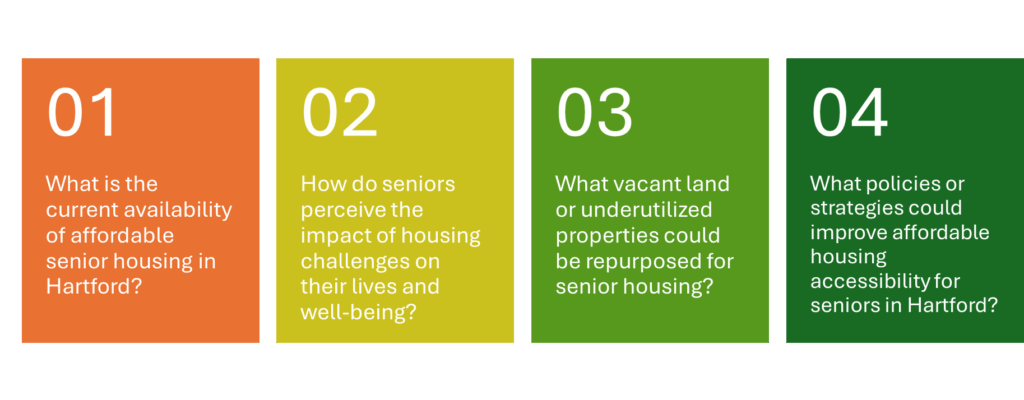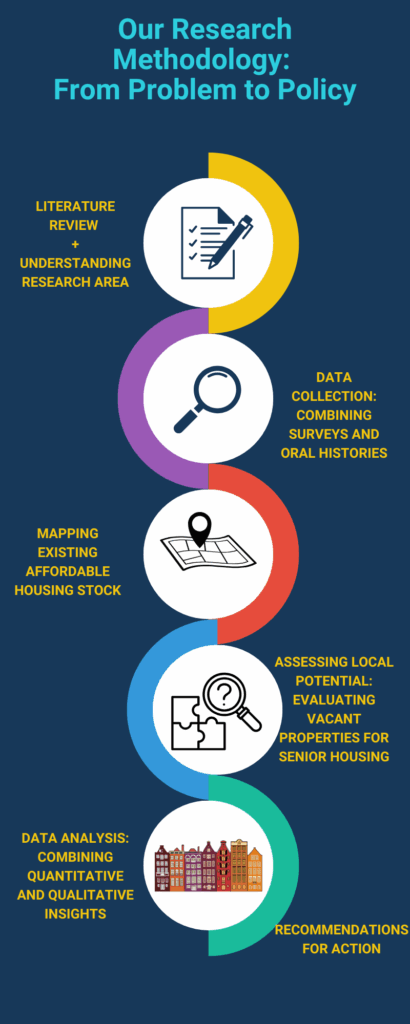Abstract
In this semester-long project, the Liberal Arts Action Lab collaborated with the Maple Avenue Revitalization Group (MARG), which identified a critical need to expand access to affordable senior housing in Hartford. Many long-time residents are being forced to relocate outside the city in search of affordable options, only to return frequently for medical care, social services, and community connections. This displacement disrupts social ties and diminishes quality of life.
To address this issue, our team aimed to: (1) understand the housing challenges seniors face; (2) assess the current supply of affordable senior housing in Hartford; (3) identify potential sites for new development; and (4) provide policy recommendations based on best practices from other cities.
We used a mixed-methods approach. We reviewed scholarly literature on senior and affordable housing, examined local housing reports, and analyzed demographic and housing statistics, including data from the Connecticut Housing Finance Authority and the National Preservation Database. We also learned from experts, including a guest speaker from Mutual Housing, and incorporated community-based perspectives through 31 surveys at the South End Wellness Center and three oral history interviews with local seniors. Additionally, we surveyed vacant and underutilized properties in the Frog Hollow, Barry Square, and South End neighborhoods to assess potential sites for senior housing development.
Our findings indicate a shortage of affordable, accessible housing units for Hartford’s growing senior population—especially in neighborhoods where seniors already have strong community ties. Survey and interview responses revealed the emotional and practical toll of housing insecurity, including displacement from long-time homes and communities. At the same time, our fieldwork identified vacant and underused properties in key neighborhoods that could be repurposed for senior housing, offering real opportunities to support aging in place and community stability. These findings will support ongoing advocacy efforts to promote housing solutions that allow seniors to remain active and connected members of their communities.
Project Need and Research Questions
Hartford, like many urban centers, faces a housing crisis, particularly for low-income and elderly residents. The city has a significant population of seniors, many of whom rely on fixed incomes Adults aged 55 and older make up 22% of Hartford’s population, which amounts to 26,268 individuals (ACS, 2023). However, rising housing costs (as of the 2019–2023 American Community Survey (ACS) 5-Year Estimates, the median gross rent in Hartford is $1,221 per month) and limited availability of subsidized senior housing create significant barriers to aging in place.
According to data from the Connecticut Housing Finance Authority (CHFA) and local housing reports, the demand for affordable senior housing far exceeds supply. Many senior housing units have long waitlists, and the limited availability of subsidized options forces residents to relocate. This is especially problematic in Hartford’s South End, where many seniors depend on community services provided by organizations like the South End Wellness Center.
Given these challenges, this project seeks to answer the following RESERACH QUESTIONS:


Community Partner
Maple Avenue Revitalization Group
Our project was developed in partnership with the Maple Avenue Revitalization Group (MARG), a Neighborhood Revitalization Zone representing Hartford’s Barry Square and South Green neighborhoods. MARG approached our team to explore strategies to expand access to affordable senior housing in the community.
Established on September 16, 2001, MARG operates under the framework of the 1995 Connecticut State Legislature’s Public Act 95-340, “An Act Establishing a Neighborhood Revitalization Zone Process.” (MARG, n.d.). According to MARG’s website:
“Our mission is to transform our neighborhood into one that is safe, economically successful, aesthetically attractive, environmentally healthy, and culturally vibrant. This is achieved by fostering a cooperative effort among residents, businesses, and government entities to establish a shared vision for the community.” (MARG, n.d.).
MARG continues to be a strong advocate for residents and plays a key role in identifying local challenges and guiding neighborhood-based solutions.
Our Research Approach
We define the need, center community voices, identify what we can do locally, and then connect it to larger systems and models; moving from problem → people → potential → policy.
